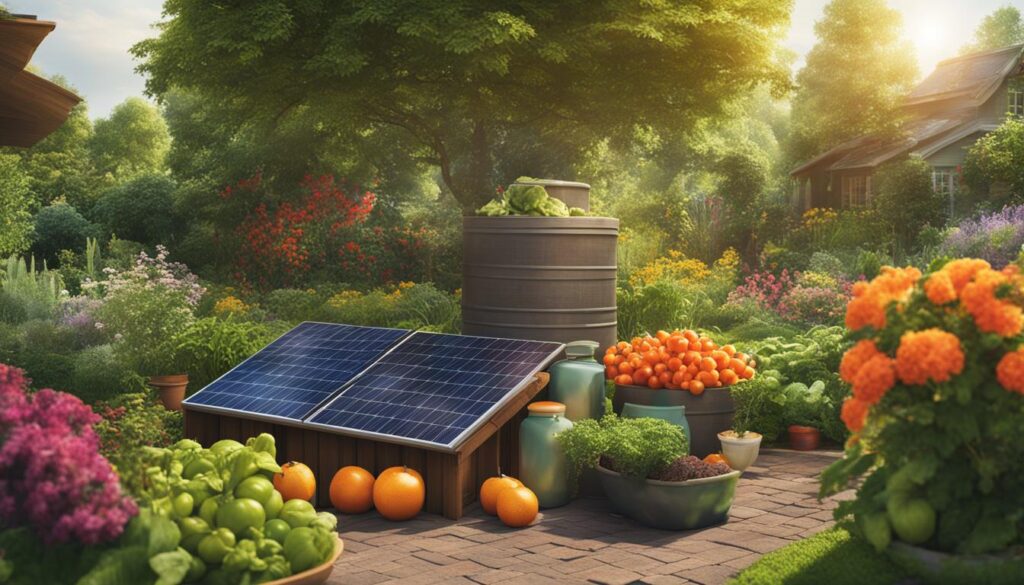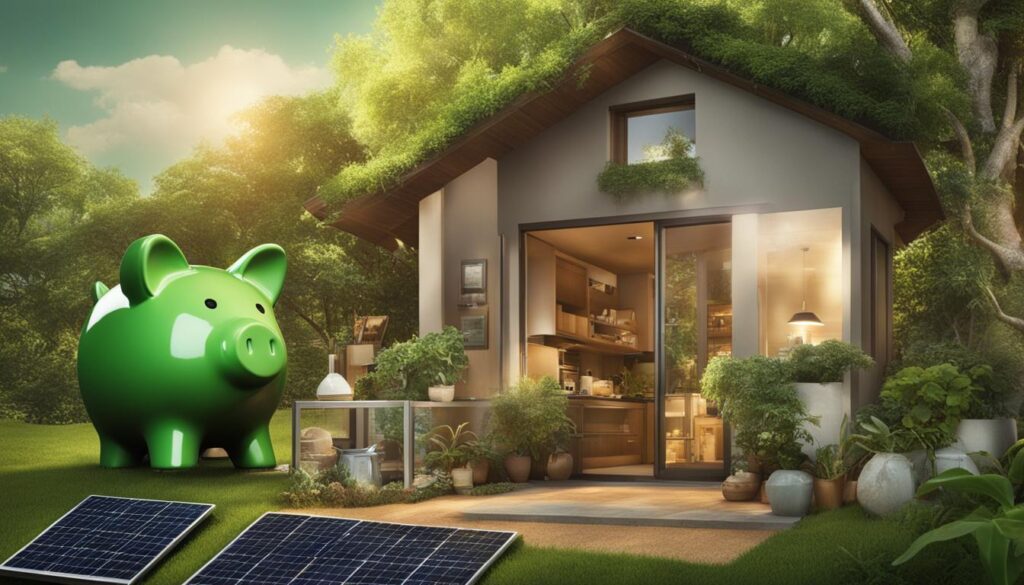Climate change and environmental degradation have become pressing issues that require immediate action. Sustainable living offers a solution that not only helps combat these challenges but also brings financial benefits. By adopting an eco-friendly lifestyle, individuals can contribute to a greener future while enjoying the advantages of financial sustainability. In this article, we will explore the concept of sustainable living and the various ways it can positively impact both the environment and our wallets.
Key Takeaways:
- Sustainable living reduces environmental impact and pollution.
- It improves air and water quality.
- Sustainable practices conserve natural resources.
- It creates healthier living environments.
- Sustainable living increases economic efficiency.
What is Sustainable Living?
Sustainable living is a lifestyle that aims to reduce our impact on the environment by using renewable energy sources, reducing waste, and conserving resources. It involves making conscious choices that benefit the planet and future generations. By adopting sustainable practices, individuals can save money on energy bills and contribute to a more sustainable future.
One of the main aspects of sustainable living is focusing on energy efficiency. By using energy-saving appliances and implementing energy-efficient practices at home, such as proper insulation and using natural light, individuals can reduce their energy consumption and lower their utility bills. Additionally, choosing renewable energy sources like solar or wind power can further decrease reliance on fossil fuels and provide long-term cost savings.
Another key component of sustainable living is resource conservation. By embracing practices such as recycling, water conservation, and minimizing waste, individuals can not only lessen their environmental impact but also save money. Recycling reduces the need for raw materials, saving energy and reducing production costs. Water conservation techniques like installing low-flow fixtures and collecting rainwater can significantly lower water bills. Minimizing waste by composting and reusing items can also lead to substantial savings over time.

What is Sustainable Living?
The Advantages of Sustainable Living
Sustainable living offers numerous advantages that encompass both environmental and financial benefits. By embracing a green lifestyle, individuals can make a positive impact on the planet while also saving money and planning for a more eco-friendly future.
Environmental Protection
One of the key advantages of sustainable living is its contribution to environmental protection. By reducing our carbon footprint through practices such as energy efficiency, waste reduction, and reliance on renewable energy sources, we can help combat climate change and preserve natural resources for future generations.
Implementing sustainable practices also improves air and water quality, creating healthier living environments. By choosing eco-friendly transportation options, such as walking, biking, or using public transit, we can reduce air pollution and promote cleaner air in our communities. Conserving water and preventing its pollution can help safeguard our water sources and ecosystems.
Energy Efficiency and Savings
Another advantage of sustainable living is the potential for energy efficiency and cost savings. By adopting energy-saving habits and investing in energy-efficient appliances, individuals can reduce their energy consumption and lower their utility bills. Installing solar panels or using alternative energy sources can further decrease reliance on fossil fuels and provide renewable energy solutions for homes and businesses.
Additionally, sustainable living encourages the use of natural light and natural ventilation, reducing the need for artificial lighting and air conditioning. By making these conscious choices, individuals can enjoy substantial savings on their energy expenses while lessening their environmental impact.
Resource Conservation
Sustainable living promotes resource conservation, ensuring the responsible and efficient use of natural resources. Through practices such as recycling, reusing, and reducing waste, individuals can minimize their impact on landfills and preserve valuable resources. By choosing products and materials made from recycled or sustainable materials, we can support the circular economy and reduce the demand for new resources.
In addition to conserving resources, sustainable living also encourages mindful consumption and conscious purchasing decisions. By prioritizing quality over quantity and investing in durable, long-lasting products, individuals can reduce their overall consumption and save money in the long run.
The Financial Benefits of Sustainable Living
The financial benefits of sustainable living extend beyond energy savings and resource conservation. Embracing a green lifestyle can create economic opportunities, attract eco-conscious customers, and contribute to the growth of sustainable industries.
Businesses that adopt sustainable practices often experience cost savings through reduced energy and water expenses, waste management efficiencies, and improved brand reputation. Consumers are increasingly supporting eco-friendly businesses, making sustainability a competitive advantage in the marketplace.
Furthermore, sustainable living promotes financial planning by encouraging individuals to adopt responsible spending habits, prioritize savings, and invest in long-term sustainability. By managing financial resources wisely, individuals can achieve both personal and environmental financial goals.

Tips for Practicing Sustainable Living
Practicing sustainable living not only benefits the environment, but it can also have a positive financial impact. By adopting eco-friendly habits and making mindful choices, individuals can effectively manage their sustainable living budget while contributing to a greener future.
Reduce Your Carbon Footprint
One of the key aspects of sustainable living is reducing your carbon footprint. This can be achieved by minimizing energy consumption, such as turning off lights and electronics when not in use, utilizing energy-efficient appliances, and opting for renewable energy sources like solar panels. By reducing energy usage, individuals can save on utility bills and lower their overall expenses.
Choose Eco-Friendly Products and Practices
Another way to practice sustainable living is by choosing eco-friendly products and practices. Look for products that are made from sustainable materials, have minimal packaging, or are certified as environmentally friendly. Additionally, consider adopting sustainable practices like composting, using reusable shopping bags, and avoiding single-use plastics. These small changes can have a positive impact on the environment and save money in the long run.
Conserve Resources at Home and Work
Conserving resources is a crucial aspect of sustainable living and can contribute to financial savings. Implement water-saving measures such as installing low-flow fixtures and using rainwater for irrigation. At home, ensure proper insulation to reduce energy waste and consider investing in energy-efficient appliances. In the workplace, encourage employees to turn off lights when not in use and set up recycling programs. These resource conservation efforts can lead to cost savings and a more sustainable future.
Make Smart Food Choices
Food choices also play a role in sustainable living and can impact both the environment and your budget. Opt for locally sourced, organic, and seasonal produce to support local farmers and reduce greenhouse gas emissions associated with long-distance transportation. Additionally, reduce food waste by planning meals, composting food scraps, and using leftovers creatively. Making smart food choices not only promotes sustainable agriculture but can also lead to financial savings by reducing food expenses.
| Benefit | Impact on Budget | |
|---|---|---|
| Reducing Carbon Footprint | Helps mitigate climate change and promotes environmental sustainability. | Lower energy bills and reduced expenses on utilities. |
| Choosing Eco-Friendly Products | Reduces environmental impact and supports sustainable practices. | Long-term savings by avoiding the need for frequent replacements and reducing waste. |
| Conserving Resources | Preserves natural resources and reduces ecological footprint. | Lower water and energy bills, reduced maintenance costs for appliances and infrastructure. |
| Making Smart Food Choices | Promotes sustainable agriculture and reduces food waste. | Reduced expenses on groceries and minimized food waste. |
Conclusion
Sustainable living not only helps protect the environment but also offers financial benefits. By adopting a sustainable lifestyle, individuals can achieve financial sustainability while making a positive impact on the planet. One of the significant advantages of sustainable living is the potential for reducing energy costs. By implementing energy-efficient technologies and practices, individuals can save money on their monthly bills and allocate those savings towards other areas of their sustainable living budget.
Furthermore, embracing sustainable practices can attract customers who prioritize eco-friendly businesses. As sustainability becomes increasingly important to consumers, businesses that adopt sustainable practices can gain a competitive advantage and attract a larger customer base. This increased demand can have a positive impact on the financial sustainability of these businesses, creating a win-win situation for both the environment and their bottom line.
Managing a sustainable living budget also involves making conscious choices when it comes to resource conservation. By reducing waste, reusing materials, and recycling whenever possible, individuals can save money and contribute to a more sustainable future. Additionally, being mindful of our carbon footprint and making eco-friendly choices can have long-term financial benefits by reducing our impact on the environment and avoiding potential costs associated with climate change and resource scarcity.
In conclusion, sustainable living is not only an ethical choice but also makes financial sense. By being proactive in our approach to sustainability and making small changes in our daily lives, we can unlock the benefits of financial sustainability while creating a greener and more sustainable future for generations to come.
FAQ
What is sustainable living?
Sustainable living is a lifestyle that aims to reduce our impact on the environment by using renewable energy sources, reducing waste, and conserving resources.
What are the advantages of sustainable living?
The advantages of sustainable living include environmental protection, energy efficiency, resource conservation, improved air and water quality, healthier living environments, economic efficiency, and raising awareness for future generations.
How can sustainable living benefit me financially?
Sustainable living can benefit you financially by reducing energy costs, attracting customers who prefer eco-friendly businesses, and promoting financial sustainability through mindful resource conservation.
How can I practice sustainable living?
You can practice sustainable living by reducing your carbon footprint, choosing eco-friendly products and practices, conserving resources at home and work, making smart food choices, and reusing and recycling whenever possible.
What is the financial impact of sustainable living?
By implementing sustainable practices, individuals can save money on energy and water bills, effectively manage their sustainable living budget, and experience the financial benefits of living a green lifestyle.

